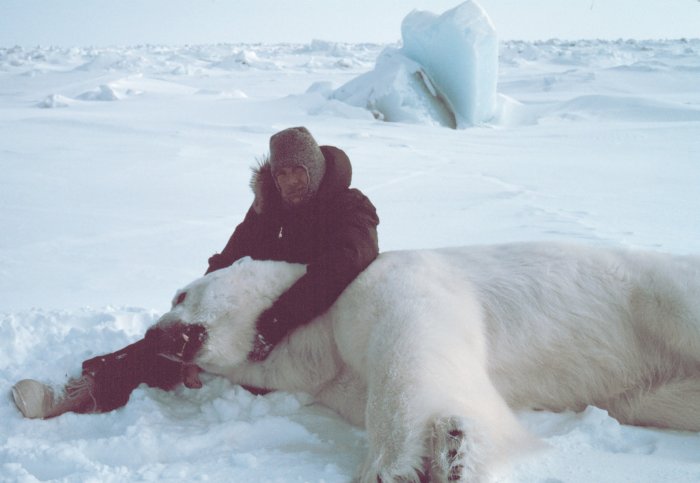
A polar bear which collapsed from heat exhaustion before it could be shot.
I have in my possession a copy of one of the most authoritative books ever written on Arctic sea ice, including a section on the warming of the Arctic. It is written by one of the pioneering researchers in Arctic sea ice, N.N Zubov, a Russian, who spent his career studying the Arctic region.
His observations of warming in the Arctic, which he described as not localized, but universal, are taken from his book entitled Arctic Ice. I have excerpted several pertinent passages, which I’m sure will convince you that warming of the Arctic can scarcely be denied:
Along with the fluctuations in ice abundance in each individual sea from year to year, in late years a most interesting phenomenon has been observed – a warming of the Arctic, as evidence by a gradual and universal decrease in ice abundance. The main evidence of this general warming of the Arctic are:
1. Receding of glaciers and “melting away” of islands….all the Greenland glaciers which descend into Northeast Bay and Disko Bay have been receding since approximately the beginning of the century. On Franz Joseph Land during recent years several islands have appeared as if broken in two. It turned out they had been connected up to that time by ice bridges. …I noted a great decrease in the size of (Jan Mayan and Spitzbergen) glaciers. Ahlman terms the rapid receding of the Spitzbergen glaciers “catastrophic”.
2. Rise of air temperature. (Over the last 20 years) the average temperature of the winter months has steadily increased…(in the last 10 years) in the whole Arctic sector from Greenland to Cape Chelyuskin there has not been a single (negative) anomaly of average annual and monthly winter temperatures, while the positive anomalies have been very high….
3. Rise in temperature of Atlantic water which enters the Arctic Basin…the temperature of surface water and of Gulf Stream water has steadily risen…
4. Decrease in ice abundance….15% to 20% (over 20 years)….In earlier times, polar ice often approached the shores of Iceland and interfered with fishing and navigation. For the past 25 years ice has not appeared in significant quantities.
5. Increase in speed of drift ice.
6. Change in cyclone routes. There is no doubt that the increase in air temperatures, increase in Atlantic water temperatures, intensification of ice drift, etc., are closely connected with an intensification of atmospheric circulation, and in particular with a change in cyclonic activity at high latitudes. Vize shows that Atlantic cyclones are now shifting considerably north, by several hundred km, from their courses in the period before the warming of the Arctic.
7. Biological signs of warming of the Arctic. …fish have ranged further and further to the north…cod in large quantities have appeared along the shores of Spitzbergen and Novaya Zemlya…also mackerel, dolphin where formerly were not found…during recent years fishing has gradually shifted into the Arctic waters, and this unquestionably must be ascribed in considerable degree to the warming of these waters….many heat-loving bottom organisms are now found in regions these organisms were not found (30 years ago). Knipovich says: “ In a matter of fifteen years…there occurred a change…such as is usually associated with long geological intervals”.
8. Ship navigation. …a number of ship voyages (were made) which could hardly have been accomplished in the preceding cold period.
Still more remarkable is the fact that the warming of the Arctic is not confined to any particular region.
I find these observations to be quite compelling evidence that warming of the Arctic is indeed unprecedented. Who would dare deny it? Clearly, we must do something about our carbon dioxide emissions!!
NOTE: Oh, silly me. This book was written in the late 1930’s. Nevermind.

 Home/Blog
Home/Blog



